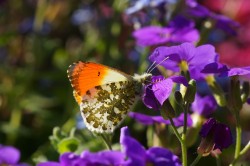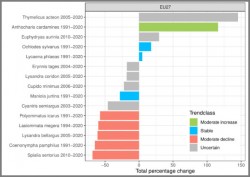Press Release, 16. May 2023
Butterflies on the decline
Research shows that the numbers of butterflies in meadows and pastures of Europe are in a continuous decline. A new EU regulation aims to stop this trend.
Grassland butterflies will soon play an even greater role in EU nature conservation legislation. Based on the occurrences and population trends of butterflies, the member states are supposed to document the progress they have made in implementing the planned "Nature Restoration Law". The Butterfly Grassland Indicator, recently calculated for the eighth time by European foundation "Butterfly Conservation Europe", is to be used for this. This analysis, which also includes data and expertise from many volunteers in Germany - coordinated by experts from the Helmholtz Centre for Environmental Research (UFZ) in Halle - shows an urgent need for action. This is because the situation of grassland butterflies in Europe has deteriorated considerably since the first calculations in 1990.

Photo: Ulrike Schäfer

Photo: Butterfly Conservation Europe & SPRING/eBMS
The diagnosis sounds worrying: More than 80% of habitats in the EU are currently considered vulnerable. This has negative consequences on their functional capability and thus the services they provide for humans. In order to counter this, the European Commission has proposed a new set of rules. This "Nature Restoration Law" is one of the key elements of the EU Biodiversity Strategy 2030 to be published this May. It defines binding targets for the entire EU for the renaturation of various ecosystems. Two years after the regulation enters into force, member states must submit plans on how they intend to meet these targets. They must also document the success of their measures.
However, the latter is not so easy. So far, there are only a few indicators that can reliably show the state of biodiversity. For most animal and plant groups, there is a lack of comparable data across Europe from which to assess the development of populations. The few exceptions include birds, bats, and butterflies.
"Butterflies in particular are ideal bioindicators", says agricultural ecologist Prof. Dr Josef Settele from the UFZ. This is because these insects occur in a wide range of habitats and react sensitively to environmental changes. With their specific requirements, they are often representative of many other insects. Finally, they are eye-catching, attractive, and popular. It is thus relatively easy to motivate volunteers to take part in scientifically oriented butterfly counts.
Such actions are becoming increasingly popular. For example, in 2005 the UFZ and the Gesellschaft für Schmetterlingsschutz (GfS) launched a citizen science project called "Tagfaltermonitoring Deutschland" (Butterfly Monitoring Germany) in which anyone interested can participate. Since then, butterfly enthusiasts from all over Germany have been walking fixed routes from spring to autumn to record the number of individuals and species they have seen. Similar monitoring programmes now exist in most other European countries. "Around 5,000 volunteers spread all over Europe are now taking part - all following the same protocol", says Settele.
The data are collected and analysed in the central "European Butterfly Monitoring Scheme" (eBMS) database, managed by UKCEH and mirrored at UFZ and the Dutch "Vlinderstichting". In this way, the population development of individual species can then be tracked. Common trends for the inhabitants of certain habitats can also be identified.
This is precisely the idea behind the Butterfly Grassland Indicator, which is based on the population trends of 17 typical species of meadows and pastures. If the positive and negative trends in these species roughly balance each other out, the indicator remains at the same level. If more species decline than increase in the same period, the value decreases - and vice versa. Lower values thus indicate greater problems among grassland dwellers.
The latest results of these calculations, which include data from 1990 to 2020, therefore do not bode well. The analysis, which was also co-financed by the EU project SPRING (Strengthening Pollinator Recovery through Indicators and monitoring) coordinated by the UFZ, shows only one winner: In the 27 memberstates of the EU, only the Orange Tip (Anthocharis cardamines) displayed a moderate increase. Three species are stable: the Large Skipper (Ochlodes sylvanus), the Common Copper (Lycaena phlaeas), and the Meadow Brown (Maniola jurtina). Five species - from the Common Blue (Polyommatus icarus) to the Wall Brown (Lasiommata megera) - are showing declining populations. "The biggest loser in recent years has been the large blue (Phengaris arion), which for example has disappeared completely in the Netherlands", says Settele. For the remaining species of the 17 grassland inhabitants studied, there is either no clear trend or too little data.
The picture becomes even less favourable if we look not only at the EU but rather at Europe as a whole. Then there are no species on the rise and only three are stable. Six show a moderate and one even a strong decline.
In view of these developments, it is not surprising that the grassland indicator is now at a considerably lower level than before. In the last 10 years alone, the calculated value for the EU has fallen by 32% - and that for Europe as a whole by as much as 36%. The crisis of the grassland dwellers has apparently already taken hold of the entire continent. This is becoming increasingly more evident the more information is provided by the volunteer butterfly counters from different countries. "The declines are not confined to north-western Europe", says Chris van Swaay of Butterfly Conservation Europe. "However, some species in the South and East are doing much better".
He and his colleagues attribute the dwindling butterfly occurrences mainly to changes in agriculture. In north-western Europe, for example, the over-intensive use of meadows and pastures has a particularly unfavourable effect. The heavy use of fertilisers often also pollutes adjacent protected areas with excessive amounts of nitrogen. In the rest of Europe, the main problem is the complete abandonment of cultivation. That’s because grassland butterflies also cope poorly with this.
According to the experts, a large set of measures is necessary in order to save them. It is important to promote the sustainable use of meadows and pastures, to create new valuable habitats, and to better connect the existing ones. And most grassland butterflies would also benefit from effective climate change mitigation. "Despite all efforts, these insects are still declining in many parts of Europe", says van Swaay. "We hope that the upcoming Nature Restoration Law can stop this decline so that our children can also enjoy butterflies in flower-rich grasslands".
Publication:
Van Swaay, C.A.M., Dennis, E.B., Schmucki, R., Sevilleja, C.G., Åström, S., Balalaikins, M., Barea-Azcón, J.M. , Bonelli, S., Botham, M., Cancela, J.P., Collins, S., De Flores, M., Dapporto, L., Dopagne, C., Dziekanska, I., Escobés, R., Faltynek Fric, Z., Fernández-García, J.M., Fontaine, B., Glocovcan. P., Gracianteparaluceta, A., Harpke, A., Harrower, C., Heliölä, J., Houard, X., Kolev, Z., Komac, B., Kühn, E., Kuussaari, M., Judge, M., Lang, A., Lysaght, L., Maes, D., McGowan,D., Mestdagh, X., Middlebrook, I., Monasterio, Y., Monteiro, E., Munguira, M.L., Musche, M., Olivares, F.J., Õunap, E., Ozden, O., Pavlícko, A., Pendl, M., Pettersson, L.B., Rákosy, L., Roth, T., Rüdisser, J., Šašic, M., Scalercio, S., Settele, J., , Sielezniew, M., Sobczyk-Moran, G., Stefanescu, C., Švitra, G., Szabadfalvi, A., Tiitsaar, A., Titeux, N., Tzirkalli, E., Ubach, A., Verovnik, R., Vray, S., Warren, M.S., Wynhoff, I., & Roy, D.B.(2022). European Grassland Butterfly Indicator 1990-2020 Technical report. Butterfly Conservation Europe & SPRING/eBMS (www.butterfly-monitoring.net) & Vlinderstichting report VS2022.039. https://assets.vlinderstichting.nl/docs/290cb16a-e90f-4c5b-a7df-9b954d511cfa.pdf
Further information
Prof. Dr. Josef Settele
Head UFZ Department of Conservation Biology & Social-Ecological Systems
josef.settele@ufz.de
Chris van Swaay
Butterfly Conservation Europe
Chris.vanSwaay@vlinderstichting.nl
UFZ press office
Susanne Hufe
Phone: +49 341 6025-1630
presse@ufz.de
In the Helmholtz Centre for Environmental Research (UFZ), scientists conduct research into the causes and consequences of far-reaching environmental changes. Their areas of study cover water resources, ecosystems of the future, environmental technologies and biotechnologies, the effects of chemicals in the environment, modelling and social-scientific issues. The UFZ employs more than 1,100 staff at its sites in Leipzig, Halle and Magdeburg. It is funded by the Federal Government, Saxony and Saxony-Anhalt.
www.ufz.deThe Helmholtz Association contributes to solving major challenges facing society, science and the economy with top scientific achievements in six research fields: Energy; Earth and Environment; Health; Key Technologies; Matter; and Aeronautics, Space and Transport. With some 39,000 employees in 19 research centres, the Helmholtz Association is Germany’s largest scientific organisation.
www.helmholtz.de